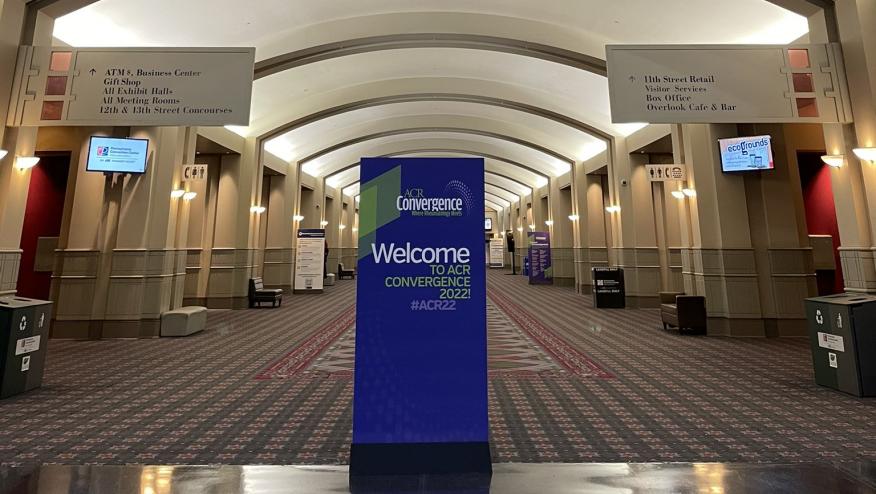ACR22 Takeaways: Pre-RA, Lupus, PsA and AS Save

ACR22 Convergence left us bountiful with information from all over the world. Here are a few of my personal highlights.
I especially enjoy the “Great Debate” every year and this year was no different. This time the discussion was centered around whether we should treat preclinical RA.
This brought up a few interesting discussions with first, how do you classify preclinical RA? Is it just someone with positive RA antibodies? Is it someone with positive antibodies and some joint pain but no inflammation? I think the main question for all of us is what do you with these patients. The answer I surmised is we don’t know but we err on the side of caution with no therapy for now but close monitoring. This is what I practice in clinic. The way I sum it up for some of my patients in this scenario is the movie Minority Report. This is a movie with Tom Cruise set in a utopian world with no crime because the “pre-crime” police catch the criminals before they even commit the crime. Sound familiar? The only problem is what do you do when there’s a mistake with the pre-crime detection? What if it detects something wrong and arrests the wrong person? This is what we face in treating pre-clinical RA. We’re not offering a simple lifestyle, diet change or even a standard dose of NSAIDs. At times we are considering DMARDs and biologics and there’s even been studies based on rituximab. For now, I don’t know if we have enough data to subject someone in the “pre-disease” state to these therapies with the small chance that they may never develop RA.
In the world of psoriatic arthritis and axial spondyloarthritis there continues to be developments in terms of biologic therapies and also how we choose these biologics.
One of the first head to head trials was a late breaking abstract (L15) comparing TNFi (adalimumab) and IL-17i (secukinumab) in terms of their efficacy in preventing radiographic progression in axial spondyloarthritis. This was a large phase III study over two years with over 900 patients randomized 1:1:1 to two different doses of secukinumab and standard dose adalimumab. Overall they found all three arms had similar efficacy in preventing radiographic progression, roughly 66% in each arm with no difference between the biologics. Although there was no significant difference between the two agents, this was a reassuring study showing us that a good majority of patients do not progress radiographically when treated appropriately with our biologic agents.
Another late breaker was L02 focusing on bimekizumab (IL-17A and IL-17F), in a phase III study for treatment of psoriatic arthritis which proved efficacy in terms of skin and joint response and has safety profile similar to other IL-17i on the market. However, in an already crowded world of therapeutics for psoriatic arthritis, and even in IL-17i alone, where will bimekizumab fit and will the fact that it is a dual IL-17A and IL-17F inhibitor separate it from the rest of the pack? Another hot topic is cycling or switching mechanisms of action in treatment of psoriatic arthritis (abstract 1600). This study looked at a registry of patients who did not respond to their initial TNFi and then what happened if they cycled to another TNFi or switched to another mechanism of action. It found that patients who switched mechanisms of action did only slightly better than patients who cycled but patients who cycled within TNFi also held their own. As we know, most of the time our decision making for biologic treatment is also hindered by outside forces and sometimes also by what we cannot prescribe.
Lastly, in the world of lupus, urinary biomarkers may be the future in monitoring therapy response in our patients with lupus nephritis. This was studied in abstract 0536. Currently we use markers like proteinuria and complements but we also know proteinuria is mostly a marker of damage and not necessarily inflammation. This study looked at a wide array of biomarkers including IL-16, macrophage activation markers such as CD163 and CD106, and found them to be high during acute inflammation but they do decrease after response to immunosuppression. These types of studies still need larger prospective trials but it is a developing field and topic. I think ultimately it comes down to how practical this will be and can these biomarkers be easily ordered by the average rheumatologist. It sounds like out of all of these candidate biomarkers CD163 may hold the most promise.








If you are a health practitioner, you may Login/Register to comment.
Due to the nature of these comment forums, only health practitioners are allowed to comment at this time.